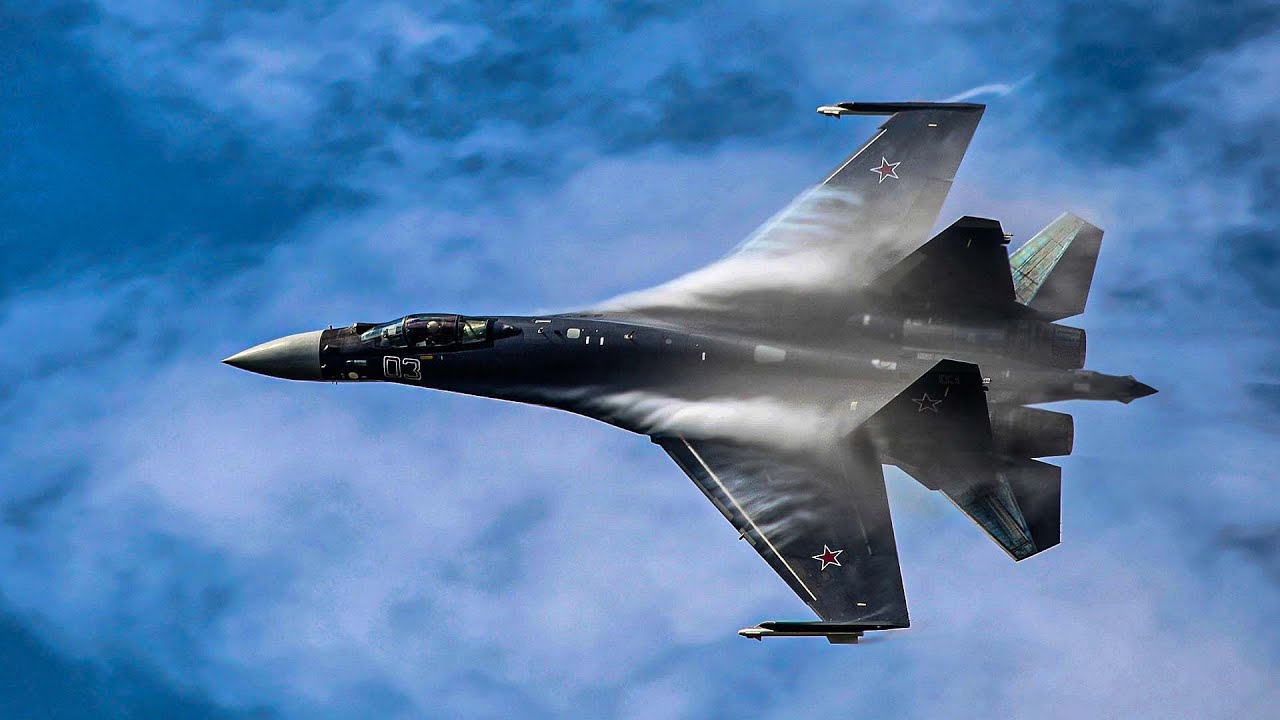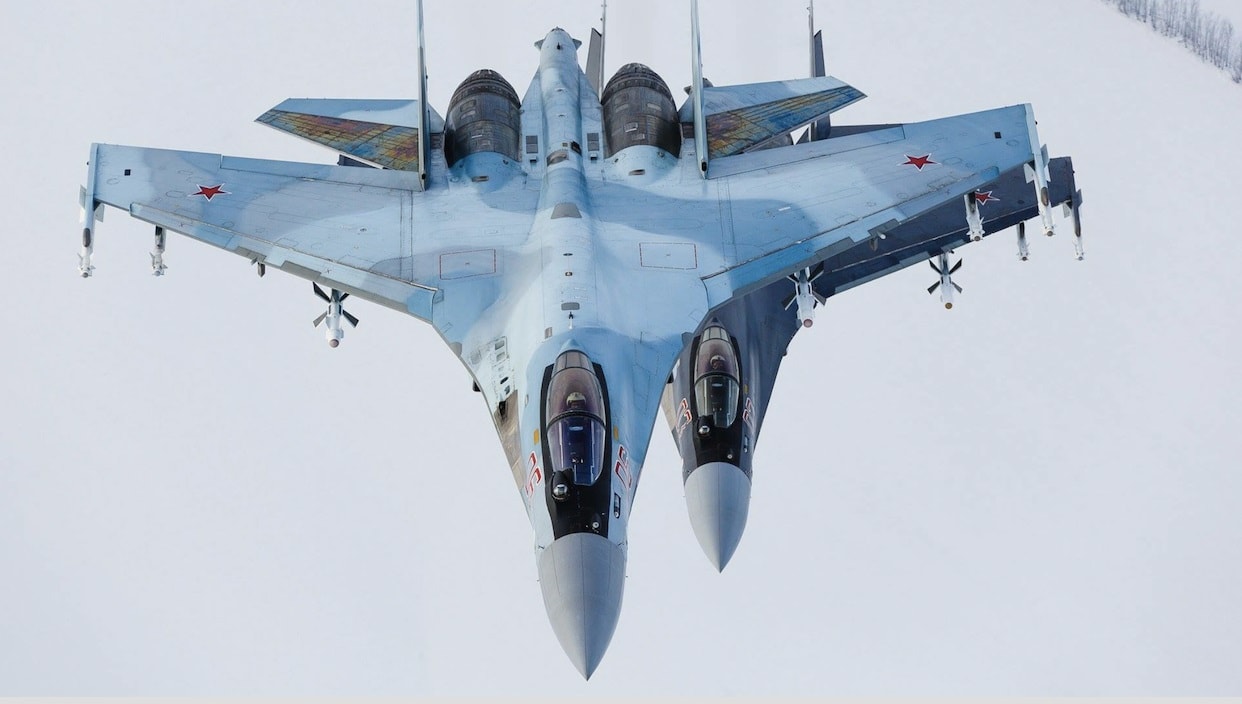A video has emerged of a Russian Su-35 fighter jet flying very low and dropping bombs while Ukrainian forces appear to make an unsuccessful attempt to shoot down the fighter.
In the video footage, Ukrainian troops seem to be on patrol when the super maneuverable Flanker emerges out of a sudden, flies at ultra-low altitude, and drops three bombs that explode in the following seconds.
In the meantime, a Ukrainian soldier tries to bring down the Russian jet by firing an anti-aircraft missile from a MANPADS. Still, the missile does not appear to have reached the fighter jet, and the fighter disappears from the sky.
Reports suggest the munitions dropped by the fighter jet were FAB-250 aerial bombs based on the intensity of the explosion.
Su-35 dropping bombs from a very low height and being fired on from a Manpad pic.twitter.com/xDxeNrA20r
— Reggie Meezer (@ReggieMeezer) October 25, 2022
Why Is Russia Using Its Most Advanced Fighter To Drop Soviet-Era Dumb Bombs?
The Su-35 is a 4.5 generation multirole fighter jet and one of Russia’s most advanced frontline combat aviation platforms, while the FAB-250 are Soviet-era, unguided high-explosive fragmentation bomb.
The severe depletion of Russia’s inventory of precision-guided munitions has prompted the Russian military to rely heavily on unguided bombs. Ukrainian intelligence believes Russia has already fired 55% of its entire stockpile of guided missiles.

According to the General Staff of Ukraine, before the beginning of the Russian Military Operation on February 24, Russia had 900 Iskander-M missiles, 500 Calibre missiles, and 440 KH-101 missiles.
Following eight months of operations, the stocks of the missiles are estimated to have reduced to around 100 Iskanders and a little more than 200 Calibre and KH-101 missiles each.
This dire state of its precision-guided capability has forced the Russian Air Force (VKS) to use its advanced 4.5 generation fighter jet in a very old-fashioned way by flying them within the range of MANPADS to attack ground targets with archaic bombs.

In his recent article for EurAsian Times, military analyst Vijender K Thakur highlighted that Russia tends to favor affordability over capability in its weapon systems, as affordable weapon systems increase Russia’s capacity to absorb losses when fighting a protracted conflict against an adversary like Ukraine that has been receiving an unending supply of equipment and ammunition from the West.
Being a skillful air combat and ground attack fighter with characteristics like sensor fusion & supermaneuverability, the Su-35 is an excellent example of this approach, according to Thakur.
A Su-35 has Missile Approach Warning (MAW) sensors to detect MANPAD launches, automated flare dispensing, and wingtip-mounted Khibiny Electronic Warfare (EW) pods to evade incoming missiles.

The flares confuse the Infrared (IR) sensors aboard the anti-aircraft missiles used for guidance. The Khibiny EW pods are intended for detecting emissions of Air Defense radars and missiles and spoofing active seekers aboard incoming missiles.
The Su-35 also has thrust-vectoring technology that redirects the engine’s thrust by tilting the exhaust nozzles side by side as well as up and down, providing the Russian 4.5 generation fighter with super-maneuverable flight characteristics to outmaneuver incoming missiles.
“Downing a Su-35 with a MANPAD requires a tremendous amount of luck. In a long-drawn war, it’s possible to get an occasional lucky shot,” Thakur said.
Therefore, a Su-35 is well suited for old-fashioned ‘seek and destroy missions,’ which means going to the target area, visually acquiring the target, and then attacking.
Thakur explained that unguided bombs could be as accurate as precision bombs when dropped from extremely low levels. “From my experience in Jaguars, you can easily get 5m accuracy when releasing a bomb from 200-ft,” he said.
How Will Russia Deal With The Shortage Of Precision-Guided Munitions?
Nevertheless, the depletion of its stockpile of precision-guided munitions in the ongoing Ukraine war poses a significant threat to Russia’s security, mainly because of the limited production capacity of the country’s defense industry.
Several Russian-guided weapons depend on Western-made semiconductor chips for guidance. The sanctions imposed by the West after the Russian invasion of Ukraine have significantly cut off the Russian defense industry’s access to Western components.
That said, Russia can locally manufacture microelectronic chips to replace Western semiconductors and revamp its production up to the level desired by the Russian military.
While it may take several months before this happens, it is not outside Russia’s capability to realize the functionality provided by Western microelectronic components, as Thakur discussed in another of his recent articles for EurAsian Times.
He explains that advancement in electronic components generally implies that it is miniaturized and not that the component has some computing capabilities that others do not.
However, Russian chip technology is 10-15 years behind high-end Western electronics. Therefore, equivalent Russian electronic components could be bulkier and heavier, which means they will occupy more space and increase the overall weight of the weapon.
The space for accommodating the larger Russian-made electronic components would most easily be created by reducing the fuel capacity, which, together with the increased weight of the weapon, will reduce its range.
The increase in weight, however, could also be offset if Russia uses its advanced composite technology.
- Contact the author at tanmaykadam700@gmail.com
- Follow EurAsian Times on Google News




